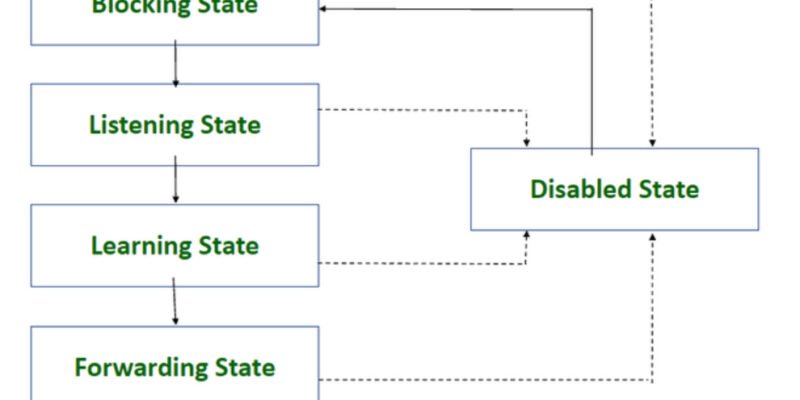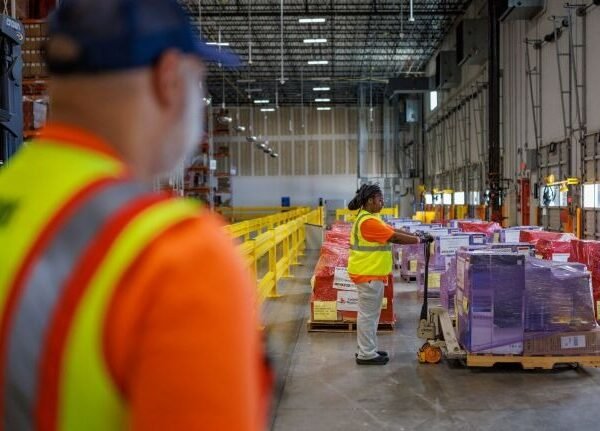STP works by assigning states to ports to regulate traffic’s path across the network while preventing loops from forming. The individual states have to fulfill specific tasks to determine the best way to go and how to steer the further forwarding process of the frames. The 5 Core States of STP
1. Blocking State
2. Listening State
3. Learning State
4. Forwarding State
5. Disabled State
1. Blocking State
Blocking StateState is one of the primary states in Spanning Tree Protocol (STP), which prevents network loops by blocking some ports to not forwarding frames or learning MAC addresses. A further examination of the Blocking State follows.
Purpose of the Blocking State
Loop Prevention: The only reason for Blocking State is to prevent loops in your network. Loops can result in broadcast storms and multiple copies of frames, leading to network congestion and instability.
Stable Network Topology: Maintaining the inactivation of redundant paths during network convergence helps stabilize the network topology.
The Properties of the Blocking State
Frame Forwarding: Ports in the Blocking State do not forward data frames. This is to be read as routers not actively forwarding traffic.
MAC Address Learning: Ports in this StateState do not learn MAC addresses, so do not update the switch’s MAC address table.
Reception of BPDUs: Ports in a blocking state will still receive and process Bridge Protocol Data Units (BPDUs). This permits them to observe modifications within the community topology and participate in the STP process.
Never Any Transmissions (Port Never): No frames, including BPDUs, are propagated across the port.
2. Listening State
The Listening state is a unique state in STP that is used as a midway transition state to help ensure that the network remains in the loop-free state and does not result in broadcast storms. Introduction to the Listening State.
Purpose of the Listening State
Setup Topology: The main reason for the Listening State is to prepare the port for involvement in the network.
Learn Topology: The port listens to BPDU to learn the topology of the network so that this port can select the best path to the root bridge.
State Transition: The listening State is the transition state before the port changes to the Learning State and learns MAC addresses.
Characteristics of the Listening State
No frame forwarding: Ports in the Listening state do not forward data frames. This avoids potential loops or network instability during the transition period.
BPDU Rx: The port is actively hearing incoming BPDUs from other switches. BPDUs carry information about the network topology, the root bridge, and their information of the best path to reach all of them.
I couldn’t resist concluding: 8- During Listening State, we need to limit how long the port will wait (using a countdown timer) before it calls it a day and moves to Learning State. Its default duration is 15 seconds for the timer
3. Learning State
The Learning State is an essential phase in the Spanning Tree Protocol (STP) process as network ports transition towards active frame forwarding while they are still learning MAC addresses. The Learning State in a Glance
Purpose of the Learning State
State Description Prepared for learning—ports still neither learn MAC addresses nor blinkSPANNING-TREE topology_betwe topology too_hello_every_Learning StateThe ports are ready to learn the MAC addresses of devices on the network.
Learning State: When ports have entered the Learning state, they start learning MAC addresses by watching the source MAC addresses of incoming frames.
State Transition: The Learning State is a transitory phase as ports move to the Forwarding State and become actively engaged in network traffic forwarding.
Characteristics Of The Learning State
Frame Forwarding: Switch ports in the learning state wait to forward frames. But they start by learning MACs to be prepared to forward frames.
Learning MAC Address: The ports listen to the source MAC addresses of incoming frames and update them to the switch’s MAC address table. This prepares the switch to make educated decisions about forwarding those packets.
This is consistent with the other STP states, where ports in the Learning State will continue to receive and process Bridge Protocol Data Units (BPDUs) from neighboring switches to monitor changes in the network topology.
Transition Time: The period during which the ports stay in the Learning State before transitioning to the Forwarding State. The default duration is 15 seconds in general.
4. Forwarding State
Forwarding State: The current operational StateState in the Spanning Tree Protocol (STP) where network ports are completely operational forwarding frames and are actually in the network topology. Forwarding State Summary Now that covers the forwarding state_PROCESSindexed by PROCESS_ID as mentioned previously to implement decision functions.
Purpose of the Forwarding State
Instead, the Forwarding State is primarily active for forwarding frames, which can be described as Active Frame Forwarding.
MAC Address Forwarding: Ports in the Forwarding State utilize the MAC address table to forward frames and allow communication between devices on the network.
Stable State: When the port has reached the Forwarding State, it is stable; if the network’s topology doesn’t change and no failures have occurred, the port can always work in this state.
Characteristics of the Forwarding State
Frame Forwarding: Ports in the Forwarding State actively forward frames to and from attached network segments. Active communication paths for network traffic
Forward by MAC Address: Ports refer to the switch’s MAC address table to learn the destination of incoming frames and forward them where appropriate.
BPDU Reception: Ports still receive and process Bridge Protocol Data Units (BPDUs) from their neighbor switch, allowing them to track network topology changes and participate in STP convergence.
5. Disabled State
Within the Spanning Tree Protocol (STP), the Disabled State is a port state that administratively lowers a network port operationally so that it does not participate in any STP operations or network communication. An Introduction to the Disabled State
Purpose of the Disabled State
Administrative Shutdown: The primary functionality of the Disable State is to show that the network administrator is administratively shutting down the network port.
Port Isolation) Disabled (Port_transmission_disable): The Disabled ports are not in the network and can not participate in STP or Network communication. This enables troubleshooting or maintenance-related tasks to be easily performed without disturbing network health.
Traits of the Disabled State
Ports in Disabled State, forward_no_frame: Ports in the Disabled StateState are utterly inactive, as they do not forward frames for network communication.
STP Exclusion: Disabled ports do not participate in the STP operation, such as BPDUs exchange and topology determination. These are not part of the STP process.
The ports enter the Disabled State due to the network admin’s administrative configuration. You can do this manually with CLI commands or a network management interface.
Also Read Interesting articles at Disboard.co.uk













